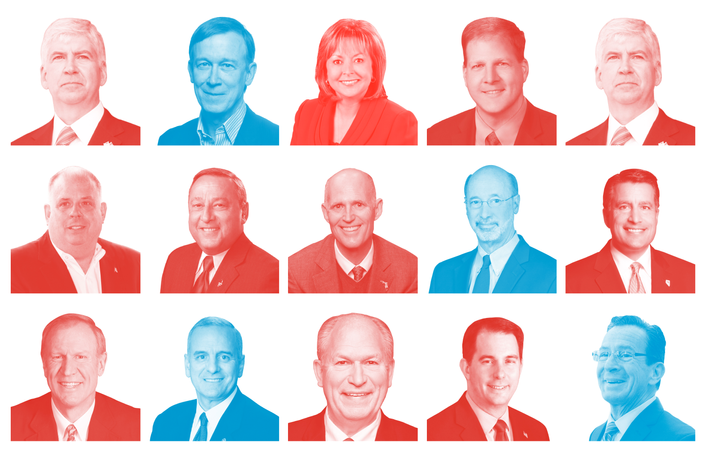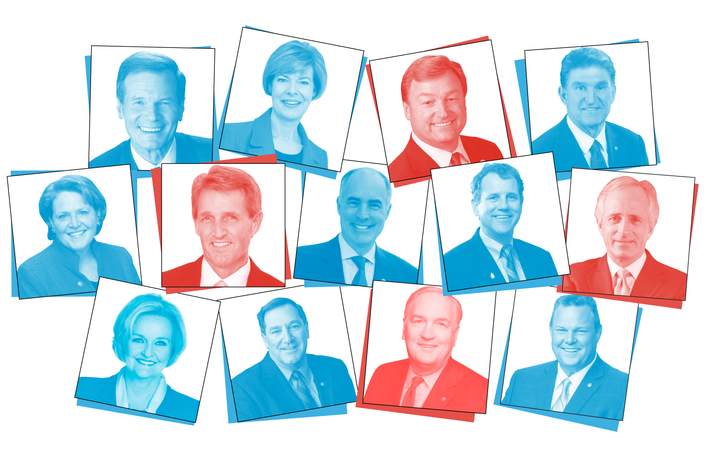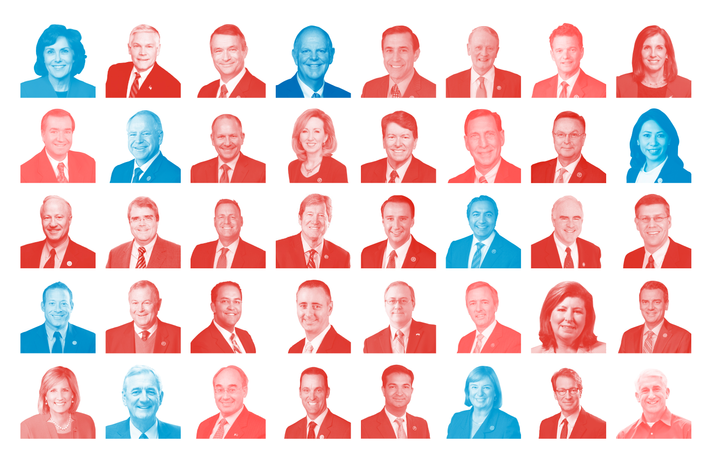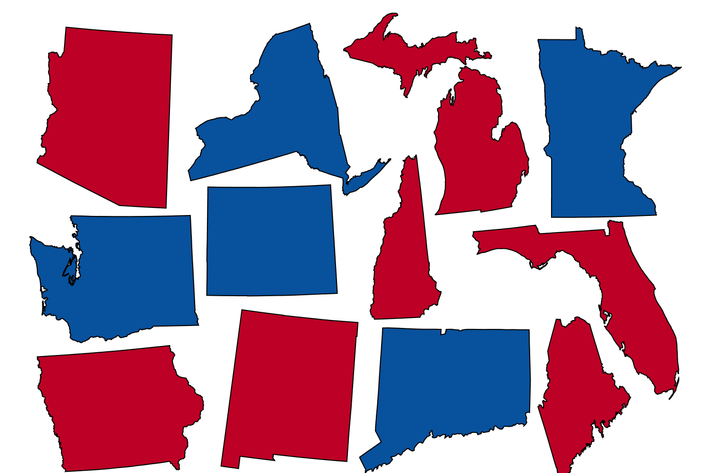Our Latest 2018 Prediction
Jump to the list of competitive seats.
This year’s gubernatorial races are especially critical, as Republicans now hold a record 26 state trifectas — meaning they control the executive branch and both state legislatures** — and governors will play a role in their state’s congressional redistricting following the 2020 Census. Democrats have steadily lost ground in both federal and state elections over the last decade thanks in part to gerrymandering — a recent AP report found that Republicans hold up to 22 more House seats than they should based on the average vote share, which is nearly enough to close the 24-member gap in the chamber. Most governors have veto power over their state legislatures’ congressional redistricting efforts, which means the more Democratic governors in power in 2020, the more the party will get out of this once-in-a-decade chance to combat Republican gerrymandering in Congress.
Democrats held 29 governors’ seats in 1994, the year of the Gingrich revolution in Congress. In that midterm year, the party lost ten states, giving Republicans a 30-to-19 seat advantage (Maine was held by an independent). Democrats have struggled ever since, and Republicans now hold 33 to Democrats’ 16 (Alaska’s Bill Walker is an independent). However, this also means that Republicans have far more seats to defend this year: 26 versus the Democrats’ nine. Democrats also got a confidence boost in 2017 thanks to wins in both Virginia and New Jersey, picking up the latter state after the crash-and-burn second term of Republican Chris Christie. And while it’s harder to predict what effect Trump may have on gubernatorial races than it is on congressional ones, Republican strategists are reportedly worried about a surge in Democratic turnout that could swing open seats. The more money Republicans spend defending vulnerable seats of their own, the less they have to swing Democratic seats. (Unfortunately for Democrats, should the scandal-plagued Missouri Governor Eric Greitens resign, his seat would be filled by the Lieutenant Governor until the next election in 2020.)
To get a better sense of how the next election cycle may play out, we’ve pulled together analysis of the most competitive seats, relying on data from election-analysis sites as well as the latest polling, approval ratings, and party target lists. As of early January, we’ve determined 15 competitive races.
The Current Map
33 Republicans
16 Democrats
1 Independent
| State | Party affiliation of Governor |
|---|---|
| Alabama | Republican |
| Arizona | Republican |
| Arkansas | Republican |
| Florida | Republican |
| Georgia | Republican |
| Idaho | Republican |
| Illinois | Republican |
| Indiana | Republican |
| Iowa | Republican |
| Kansas | Republican |
| Kentucky | Republican |
| Maine | Republican |
| Maryland | Republican |
| Massachusetts | Republican |
| Michigan | Republican |
| Mississippi | Republican |
| Missouri | Republican |
| Nebraska | Republican |
| Nevada | Republican |
| New Hampshire | Republican |
| New Mexico | Republican |
| North Dakota | Republican |
| Ohio | Republican |
| Oklahoma | Republican |
| South Carolina | Republican |
| South Dakota | Republican |
| Tennessee | Republican |
| Texas | Republican |
| Utah | Republican |
| Vermont | Republican |
| West Virginia | Republican |
| Wisconsin | Republican |
| Wyoming | Republican |
| California | Democratic |
| Colorado | Democratic |
| Connecticut | Democratic |
| Delaware | Democratic |
| Hawaii | Democratic |
| Louisiana | Democratic |
| Minnesota | Democratic |
| Montana | Democratic |
| New Jersey | Democratic |
| New York | Democratic |
| North Carolina | Democratic |
| Oregon | Democratic |
| Pennsylvania | Democratic |
| Rhode Island | Democratic |
| Virginia | Democratic |
| Washington | Democratic |
| Alaska | Independent |
If Trump’s Low Approval Rating Costs Republicans
17 Republicans
32 Democrats
1 Independent
| State | Party affiliation of Governor |
|---|---|
| Alabama | Republican |
| Arkansas | Republican |
| Idaho | Republican |
| Indiana | Republican |
| Kansas | Republican |
| Kentucky | Republican |
| Mississippi | Republican |
| Missouri | Republican |
| North Dakota | Republican |
| Oklahoma | Republican |
| South Carolina | Republican |
| South Dakota | Republican |
| Tennessee | Republican |
| Texas | Republican |
| Utah | Republican |
| West Virginia | Republican |
| Wyoming | Republican |
| Arizona | Democratic |
| California | Democratic |
| Colorado | Democratic |
| Connecticut | Democratic |
| Delaware | Democratic |
| Florida | Democratic |
| Georgia | Democratic |
| Hawaii | Democratic |
| Illinois | Democratic |
| Iowa | Democratic |
| Louisiana | Democratic |
| Maine | Democratic |
| Maryland | Democratic |
| Massachusetts | Democratic |
| Michigan | Democratic |
| Minnesota | Democratic |
| Montana | Democratic |
| Nebraska | Democratic |
| Nevada | Democratic |
| New Hampshire | Democratic |
| New Jersey | Democratic |
| New Mexico | Democratic |
| New York | Democratic |
| North Carolina | Democratic |
| Ohio | Democratic |
| Oregon | Democratic |
| Pennsylvania | Democratic |
| Rhode Island | Democratic |
| Vermont | Democratic |
| Virginia | Democratic |
| Washington | Democratic |
| Wisconsin | Democratic |
| Alaska | Independent |
If Incumbents With an Approval Rating Under 50 Percent Lose
29 Republicans
20 Democrats
1 Independent
| State | Party affiliation of Governor |
|---|---|
| Alabama | Republican |
| Arkansas | Republican |
| California | Republican |
| Connecticut | Republican |
| Florida | Republican |
| Georgia | Republican |
| Hawaii | Republican |
| Idaho | Republican |
| Indiana | Republican |
| Kentucky | Republican |
| Maryland | Republican |
| Massachusetts | Republican |
| Mississippi | Republican |
| Missouri | Republican |
| Nebraska | Republican |
| Nevada | Republican |
| New Hampshire | Republican |
| North Dakota | Republican |
| Ohio | Republican |
| Pennsylvania | Republican |
| Rhode Island | Republican |
| South Carolina | Republican |
| South Dakota | Republican |
| Tennessee | Republican |
| Texas | Republican |
| Utah | Republican |
| Vermont | Republican |
| West Virginia | Republican |
| Wyoming | Republican |
| Arizona | Democratic |
| Colorado | Democratic |
| Delaware | Democratic |
| Illinois | Democratic |
| Iowa | Democratic |
| Kansas | Democratic |
| Louisiana | Democratic |
| Maine | Democratic |
| Michigan | Democratic |
| Minnesota | Democratic |
| Montana | Democratic |
| New Jersey | Democratic |
| New Mexico | Democratic |
| New York | Democratic |
| North Carolina | Democratic |
| Oklahoma | Democratic |
| Oregon | Democratic |
| Virginia | Democratic |
| Washington | Democratic |
| Wisconsin | Democratic |
| Alaska | Independent |
But larger trends alone can’t predict individual races, where (of course) the actual candidates themselves affect the results. Below, we go deep on each competitive race, looking at a range of factors that will influence the election, including fundraising ability, statewide presidential vote in 2016, and whether challengers will face an incumbent or vie for an open seat. And we took cues from the parties themselves, each of which have identified their own target lists of vulnerable candidates and flippable seats.
Competitive Seats: Governors
Click on each candidate for an analysis of his or her race.
| State | Incumbent | Party | Margin of Victory (2014) |
Presidential Winner |
Latest 2018 Prediction |
|
|---|---|---|---|---|---|---|
| FL | Rick Scott (Open) | 1.1% | Trump 49% | toss-up | ||

Rick Scott (Open)
(republican,
Florida)
Rick Scott (Open)
(republican,
Florida)
How vulnerable is the seat?
Why is it in play? As usual with Florida politics, this gubernatorial race will have an outsize ripple effect. If Democrats take the mansion in Tallahassee, they’ll be able to fight voter suppression and veto plans for increased gerrymandering in the 2020 redistricting project. If Republicans win, they could run inkblot-wild with the redistricting pen and maintain legislative dominance, despite a larger number of registered Democrats in the state. Republicans hold the upper hand in Florida — Trump won the state, there’s a red majority in both legislative houses, and the GOP has held the governor’s chair since1999. But that lead could be less of a chasm than it appears: Trump won in 2016 by 1.2 percent here, and Scott won by that same number in2010, and only 1.1 percent in 2014, after throwing piles of his own family's money into the elections. Both Scott’s and Trump’s approval ratings hang around 50 percent. Who are the challengers? Scott has reached Florida’s two-consecutive-terms limit, and he and his millions are expected to challenge the senior Democratic senator, Bill Nelson, in 2018. The field for the open governorship is crowded, with six Democrats and 12 Republicans weighing a run. The current GOP Establishment bet is agriculture commissioner Adam Putnam, a non-flashy, well-funded former congressman with solid name recognition. State senator Jack Latvala has also filed to run, though recently leaked photos of him kissing a lobbyist could complicate his efforts. For Democrats, the legacy candidate is Gwen Graham, acentrist and former congresswoman who retains her father, the longtime senator and governor of Florida Bob Graham, as atop adviser. But the mayor of Miami Beach, Philip Levine, may be leading where it counts — in June alone, he brought in $1.7 million in a state where Republican candidates have, during some stretches this year, outraised Democrats five to one. He’s also willing to dip into his estimated $100 million net worth to fund the campaign. After Irma and the punishing 2017 hurricane season, Levine’s promise to make Florida “an international leader” in combating sea-level rise could provide some welcome sanity: The current governor has reportedly banned state officials from using the term climate change. |
||||||
| MI | Rick Snyder (Open) | 4.2% | Trump 47.3% | toss-up | ||

Rick Snyder (Open)
(republican,
Michigan)
Rick Snyder (Open)
(republican,
Michigan)
How vulnerable is the seat?
Why is it in play? Michigan’s governor race is fraught with both practical and symbolic significance. Trump won the state by a little more than 10,000 votes last fall, making the state ground zero for encroaching Republican power. If Dems can’t take it back, it’ll be seen as a bellwether for their chances of winning back power nationwide. A Democratic governor will also be crucial to fix the state’s serious gerrymandering, as the state will redraw congressional districts following the 2020 Census (Michigan has 14 representatives in the U.S. House of Representatives). It’s also a state that traditionally swings between Republican and Democratic control, leaving Democrats hopeful that eight years of Republican Rick Snyder, a former business executive and venture capitalist, will leave voters open to something different. During his two terms, Snyder became notorious for passing a right-to-work law, appointing an emergency manager to oversee Detroit’s budget, and mismanaging the Flint water crisis. He’s hovering at a 37 percent approval rating, one of the lowest in the country. Who are the challengers? Former State Senate minority leader Gretchen Whitmer is heading up the Democratic side with a progressive platform pushing for green energy and skilled trade jobs, raising the minimum wage, and expanding Medicaid. She also led a huge protest against the state’s right-to-work law back in 2012, and eight unions have already endorsed her. Challenging Whitmer from the left is Abdul El-Sayed, a 33-year-old Detroit doctor and Rhodes scholar who would be the country’s first Muslim governor. El-Sayed has proposed a statewide single-payer health-care system, which is likely to resonate in a state that went for Bernie Sanders in the 2016 Democratic primary. Whitmer has raised $1.5 million, El-Sayed $1 million — but both of them will be outspent by Shri Thanedar, an entrepreneur who’s dumped nearly $6 million of his own money into his campaign. The GOP field is led by Michigan attorney general Bill Schuette, who’s raised $2.3 million. Schuette supported the right-to-work law, which will lose him points in the heavily union state, but he also led the state’s Flint investigation in which six state and local officials were charged with manslaughter. That could help his name recognition: A September poll found that only about a quarter of likely voters don’t recognize Schuette’s name, compared to 57 percent of voters who don’t know Whitmer’s. Still, that same poll found the two neck and neck in a hypothetical match-up. |
||||||
| NV | Brian Sandoval (Open) | 47% | Clinton 47.9% | toss-up | ||

Brian Sandoval (Open)
(republican,
Nevada)
Brian Sandoval (Open)
(republican,
Nevada)
How vulnerable is the seat?
Why is it in play? There are six candidates running to replace Governor Brian Sandoval, who is term-limited. Sandoval is a rare case for the GOP; the sixth-most popular governor leads a state carried by Hillary Clinton in 2016. Best known for his $343 million education reform package, Sandoval has sowed a middle ground for Nevada, where changing demographics and urban growth are widening the partisan divide between the state’s Democratic-held corners, Washoe and Clark Counties, and its rural inlands, which vote Republican. The governor’s second-term win in 2014 came as part of the GOP’s record gains up and down the state ballot, with Democrats that year losing every constitutional office, both houses, and three congressional seats. An upset that large will be hard to repeat. Donald Trump is highly unpopular among Nevadans, who consistently elect moderates to the governor’s office. Democrats are hopeful that their top candidate can play the foil to the GOP’s hyperpartisan attorney general, Adam Laxalt, who has been compared to the president. Who are the challengers? One of the strongest candidates to emerge is Clark County Commissioner Steve Sisolak, a business-first Democrat who declined Harry Reid’s appeals to run back in 2014. Sisolak's eight years of Las Vegas governing experience could be a prominent springboard for higher office — but not without downsides. Sisolak was at the helm of a controversial $750 million public subsidy for a new Raiders stadium last year. The move, dubbed “the worst deal for a city”, stoked ire in Washoe County, home to Reno and also to Adam Laxalt, who is considered the front-runner for the GOP nomination. Laxalt, a rising GOP star, has garnered endorsements fromMike Pence andTed Cruz and, with approximately$1.5 million in his campaign fund, may be the only candidate capable of giving Sisolaka run for his money. Laxalt will have to face off in the primary against Dan Schwartz, Nevada’s self-described “Bad Boy” GOP treasurer, and Jared Fisher, a Las Vegas bike-shop owner who promises to protect Nevada’s public lands. |
||||||
| IL | Bruce Rauner | 3.9% | Clinton 55.8% | toss-up | ||

Bruce Rauner
(republican,
Illinois)
Bruce Rauner
(republican,
Illinois)
How vulnerable is the seat?
Why is it in play? The 2018 midterms will be the secondconsecutive gubernatorial race in which one of the most vulnerable incumbents in the nation is the governor of Illinois, largely due to the state’s 15-year deficit crisis. A former private equity executive and political newcomer, Bruce Rauner emerged in 2014 as the business-first candidate with the acumen to “get Illinois moving again” after years of anemic job growth and mounting debt. Rauner defeated the incumbent Pat Quinn to become the first Republican to inhabit the governor’s mansion in a dozen years. But the first-term governor has yet to “shake up Springfield” and fulfil his other pro-growth campaign promises. Today, the state’s unpaid bills are now approaching $16 billion, owing mostly to a two-year financing standoffbetween the Democratic-led legislature and Rauner, during which the state operated without a budget. In addition to that impasse, recent left turns on immigration and abortion have also contributed to Rauner’s rank as the fifth-most unpopular governor in the country, with an approval rating of just 30 percent. Who are the challengers? The race for Illinois governor is on pace to bethe costliest statewide election in U.S. history. Seven candidates have raised a combined $114,494,848. Governor Rauner, whose estimated net wealth is around $500 million, accrued more than $72 million through the end of October. If any candidate can give Rauner a run for his money it’s Democratic opponent J.B. Pritzker, brother of former Commerce Secretary Penny Pritzker and a Hyatt hotels heir. Pritzker has over $35 million banked, ten field offices, staff and consultant hires north of $1.5 million, and tactics like “Tick Tock the Budget Clock,” an anthropomorphic timekeeper that trolled Rauner during budget negotiations. Such efforts to lay the state’s ailing economy at the feet the governor helped Pritzker divert coveted labor backing from his Democratic primary rivals Chris Kennedy and Daniel Biss well ahead of the March 2018 primary. There are 23 unions in Pritzker’s camp, including the AFL-CIO. In an October Capitol Fax/We Ask America pollof 1,154 likely Democratic primary voters, Pritzker pulled out in front with 39 percent of the vote. Two gubernatorial hopefuls across the aisle are also leveraging the GOP’s fraying marriage with Rauner: William J. Kelly, a perennial candidate and Chicago-area radio show host, and State Representative Jeanne Ives, a social conservative. Ives may be a long shot, but she’s pricked the ears of Illinoisans downstate and in the suburbs, who are outraged at Rauner, after he signed a bill September 28 expanding abortion coverage for women on state employee insurance and Medicaid. |
||||||
| CO | John Hickenlooper (Open) | 3.3% | Clinton 47.2% | democrat | ||

John Hickenlooper (Open)
(democrat,
Colorado)
John Hickenlooper (Open)
(democrat,
Colorado)
How vulnerable is the seat?
Why is it in play? There are more than 30 declared candidates in the running to replace the term-limited governor John Hickenlooper, a Democrat who is on the long listof possible contenders for a 2020 presidential run. The crowded field aside, unaffiliated voters are the real X factor in this toss-up race. Now the largest voting bloc in the Rocky Mountain State, these 1.4 million Coloradans will be able to vote in either Democratic or Republican primaries for Colorado’s governorship for the first time in June. Who are the challengers? Democrats had a clear front-runner in Ed Perlmutter, a six-term congressman and former state legislator. But since Perlmutterbowed out of the race in July, Representative Jared Polis, 42, has moved to the front of the pack. Polis, a fifth-term lawmaker, has one clear advantage: He’s a multimillionaire in a state with sky’s-the-limitself-fundraising laws. Universal statewide kindergarten is front and center in his bid for the job, as is is a pledge to get Colorado running entirely on renewable energy by 2040. If Polis can get the votes, he’ll also be the state’s first gay governor. Another Democrat to watch is former state treasurer Cary Kennedy, who last summer scored an EMILY’s List endorsement and worked the fundraising circuit better than anyone else in the race. Headlining on the Republican side is the hard-core Tom Tancredo, who went official with his bid after getting the the thumbs-up from Steve Bannon in November. The former congressman and current Breitbart contributor previously ran for governor in 2010 as the Constitution Party candidate, getting 36.4 percent of the vote. Border control and stamping out funding for sanctuary cities are at the top of Tancredo’s list this time around. |
||||||
| CT | Dannel Malloy (Open) | 2.3% | Clinton 54.7% | toss-up | ||

Dannel Malloy (Open)
(democrat,
Connecticut)
Dannel Malloy (Open)
(democrat,
Connecticut)
How vulnerable is the seat?
Why is it in play? Despite presiding over Connecticut’s ongoing recovery from the 2008 financial crisis and signing widely supported and famously strict gun control legislation in the wake of the Newtown shootings, Democrat Dan Malloy eked out the narrowest of victories when he ran for reelection in 2014. Since then, his approval rating has sunk, in part because he’s never really recovered from the hit he took after a $1.5 billion tax increase in 2011, enacted to make up for a huge budget deficit. In April 2017, he announced he would not seek reelection, leaving the field open. Prior to Malloy’s tenure, the governorship was held by the GOP for 15 years. This past summer and fall, Malloy has taken hits for a protracted stalemate over the state budget; after vetoing a plan that would have cut spending to state universities and programs, he was shut out of negotiations altogether. Republicans have also attacked his handling of a renegotiated agreement with state employee labor unions. As Malloy’s approval rating has fallen, making him the least popular Democratic governor in the country, the GOP has increasingly seen an opportunity. Who are the challengers? One local op-ed writer characterized the race so far as a crowded field full of “felons, millionaires, and nobodies.” About two dozen Democrats and Republicans are interested, but most are political neophytes with little statewide name recognition. Though he’s still exploring a bid and hasn’t officially declared his candidacy, Hartford mayor Luke Bronin is currently heading up the Democratic side. He was the most popular gubernatorial candidate of either party in a recent poll, though Republicans are already trying to associate him with Malloy’s failures (he was a former staffer). Republican Themis Klarides is also facing pressure to decide on a run. The state House GOP leader is known among her caucus as a skilled negotiator and problem-solver. But she was a Trump delegate and supporter in a state that the president lost by almost 14 points, and where he remains unpopular, which would make her an easy target for attacks from the left. |
||||||
| ME | Paul LePage (Open) | 4.9% | Clinton 47.8% | toss-up | ||

Paul LePage (Open)
(republican,
Maine)
Paul LePage (Open)
(republican,
Maine)
How vulnerable is the seat?
Why is it in play? In November 2016, Maine voted to become the first U.S. state with a ranked-choice electoral system. Like in Ireland, Sri Lanka, and theNBA MVP award, constituents rank preferred candidates instead of checking just one. The unprecedented decision was inspired by the large, 37 percent swath of independent voters, who don’t always align with either party, and the 2010 election of Paul LePage, who came into the governor’s mansion with just a 38.2 percent plurality. LePage consistently ranks among the top 10 least popular governors, and he has a knack for the asinine remark: He once said that New Yorkers named “D-Money” come to Maine to sell drugs and“impregnate a young white girl”; that the IRS is the“new Gestapo”; Naloxone does not save heroin users lives, but“merely extends them until the next overdose.” In 2016, Democrats attempted to impeach LePage after an alleged blackmail scandal, but were unsuccessful. Despite going Democratic in every presidential race since 1992, Republicans are currently in control of the State Senate and the governorship. In May, the state Supreme Court ruled that the state’s new voting system violates Maine’s Constitution, though lawmakers are working to implement ranked-choice for 2018, or potentially 2022. Republicans are leading the push for repeal, with LePage calling ranked-choice “another way for sore losers to try and overturn election results they don’t like.” If and when the system is enacted, Democrats have the potential to gain: In 2016, registered independents said their views were closer to that of Democratic candidates than to those of the GOP. Who are the challengers? Seemingly everyone in Augusta has an eye on the executive office, including the attorney general, the State Senate majority leader, the State Senate president, and former governor John Baldacci. With such a deep pool, that ranked-choice system could come in handy. Attorney and Bronze Star winner Adam Cote leads the fundraising push, with about$650,000raised. The co-founder of a thermal-energy-storage company, Cote, a Democrat, describes himself as a political outsider who wants to expand Maine’s renewablesand return civility to the Blaine House in the divisive wake of LePage. The former state House speaker, Democrat Mark Eves, has a reputation for sparring with LePage while maintaining a good standing among Republicans, which could help him in this state streaked with independent voters. Among Republicans, Mary Mayhew currently leads in fundraising with a little over $75,000. The former state commissioner of Health and Human Services, Mayhew has worked closely with the governor to cut back welfare, and has received praise from LePage and an endorsementfrom Jonathan Bush, the member of the Republican dynasty most closely associated with Maine. More moderate Republicans might find a cause in Mike Thibodeau, the term-limited State Senate president, who stopped a government shutdown in 2015, clashed with LePage, and has experience winning tight races. |
||||||
| NM | Susana Martinez | 14.4% | Clinton 48.3% | democrat | ||

Susana Martinez
(republican,
New Mexico)
Susana Martinez
(republican,
New Mexico)
How vulnerable is the seat?
Why is it in play? When Susana Martinez first ran for governor, New Mexico’s government was plagued by allegations of corruption and a grand jury investigation. Martinez promised to clean house, and the strategy worked. But by her second term in office, the FBI had begun to investigate Martinez’s top political adviser;audio emerged of an inebriated Martinez interacting with a police officer; and she was being unfavorably compared to Sarah Palin. Now, Martinez has served the maximum two terms as governor of New Mexico, and state Democrats think voters may be ready for another change. Adding to that, New Mexicans are fickle gubernatorial voters: In the past 35 years, an incumbent governor has passed the reins to a successor from the same party only once. Who are the challengers? Second-term Democratic congresswoman Michelle Lujan Grisham was the first to announce she would seek the job, and was quickly endorsed by EMILY’s List. The head start has payed off: She raised $1.4 million between April and October, and has released a detailed economic agenda. The most recent polls have Lujan Grisham miles ahead of her challengers: 75 percent of likely Democratic voters said they would support her, compared with only 10 percent for Jeff Apodaca, a former Univision exec and son of a past New Mexico governor. Congressman Steve Pearce, who has the dubious honor of being the least conservative member of the Freedom Caucus, is the sole GOP candidate. He’s raised just over $1 million since he entered the race, including from oil and gas companies and Donald Rumsfeld. Though Pearce has often taken a hard line on undocumented immigration, he is distancing himself ever so slightly from Trump’s immigration policy, and is against the proposed border wall. But a few critical statements may not be enough in a state that is 48 percent Hispanic. |
||||||
| PA | Tom Wolf | 9.8% | Trump 48.2% | democrat | ||

Tom Wolf
(democrat,
Pennsylvania)
Tom Wolf
(democrat,
Pennsylvania)
How vulnerable is the seat?
Why is it in play? Despite a Republican majority in theState Legislature, governor Tom Wolf has boosted funding for public schools, legalized ride-sharing, enactedpension reform, andlimited fracking in the state that helpedpioneer the technique. In June, Wolf wrote to Jeff Sessions that,“We do not need the federal government getting in the way” of the state’s medical-marijuana initiative. But, an accomplished first-term report card doesn’t leave Wolf untouchable in 2018; his approval rating hasn’t broken 50 percent this year. The Trump victory — Republicans’ first presidential win in Pennsylvania since 1988 — proved the inherent flaw in the Democratic strategy of courting cities and suburbs and cold-shouldering Rust Belt counties. Wolf has been criticized for a dull campaign style and anabsent public presence as governor. To win reelection, he’ll have to play up his public role and perform well outside of Philadelphia, Pittsburgh, and Allentown, his metropolitan path to victory in2014. Between now and next November, Wolf has two major opportunities to prove himself to Pennsylvania voters. The state faces a shortfall of $2.3 billion in the 2017–2018 budget, which Wolf managed by adding a $1-per-pack excise boost on cigarettes and borrowing against future profits from the state liquor authority — perhaps wrangling the GOP legislature could convince voters of his efficacy. Pennsylvania also suffers acutely from the opioid epidemic — according to the DEA, 4,642 people died from opioid overdose in 2016. Cutting the OD rate with initiatives like buyback programs and prescription decreases would be a huge victory in public health and politics — the growth of overdoses among white males largely lines up with the Trump vote. Who are the challengers? Wolf is safe in the primaries, but State Senator Scott Wagner represents the strongest challenge from the right. A trucking and trash magnate, he is running a by-the-book GOP campaign of tax cuts, lobbying reform, and limited government. Wagner is also likely to reel back Pennsylvania’s clean-power successes, given that he has credited global warming to Earth’s “moving closer to the Sun.” Paul Mango, director of a consulting firm focused on health care, has also entered the GOP race, with a platform of health-care reform and cutting taxes — on conservative talk radio, he called the governor“Thomas ‘The Tax Engine’ Wolf.” |
||||||
| OH | John Kasich (Open) | 30.6% | Trump 51.3% | republican | ||

John Kasich (Open)
(republican,
Ohio)
John Kasich (Open)
(republican,
Ohio)
How vulnerable is the seat?
Why is it in play? John Kasich has held the governorship since 2010 and was reelected by a huge margin in 2014, but he is term-limited and can’t run again. Ohio Republicans also hold both chambers of the state house, and have since 2011. But Democrats performed well in 2017 municipal elections, not only in cities but also in some rural areas. The Republican primary campaign has so far been contentious; if the four big-name GOP candidates pull each other down, perhaps there will be room for one of their Democratic rivals to claim the high road, and the advantage. Who are the challengers? Four Republicans, four Democrats, and a handful of still-undecided stragglers have entered the race. The GOP field is full of big names with strong fundraising ability. Ohio attorney general Mike DeWine has built his campaign around his response to the opioid epidemic, which has devastated the state. He released a 12-point recovery plan aimed to beat back the crisis, and is playing up his record, including the lawsuit he filed earlier this year against drug manufacturers for allegedly fueling the crisis with fraudulent marketing practices. He has more cash on hand than any of his opponents and has picked up some early county-level GOP endorsements. Secretary of State Jon Husted is another strong contender, having raised far and away more individual contributions than any other Republican. But he’s locked in an ugly battle with fellow candidate Jim Renacci that’s distracting from his positions on the issues. Kasich has endorsed his lieutenant governor, Mary Taylor, to succeed him. But she hasn’t benefited from her association with Kasich, as he’s increasingly taken flak from the right for his moderate policies, such as his opposition to repealing Obamacare. Taylor is attempting to make her own name by suggesting that the state roll back Kasich’s hard-won Medicaid expansion. Kasich didn’t rescind his support, but he did let his dissatisfaction be known. The Democrats are far behind the Republicans in both fundraising and name recognition, though both of those things will change if Richard Cordray, former head of the Consumer Financial Protection Bureau, throws his hat into the ring. (Famed Ohioan Jerry Springer is also reportedly pondering a run.) Among those who have already declared, Dayton mayor Nan Whaley is an early standout. She’s overseen steady economic progress in Dayton, and has centered her campaign around economic growth, job creation, and increased educational opportunity, including a proposalfor universal access to community college. There’s also William O’Neill, who shot himself in the foot early on with a maladroit Facebook post about his sexual history and has said he won’t run if Cordray does. |
||||||
| AK | Bill Walker | 2.2% | Trump 51.3% | toss-up | ||
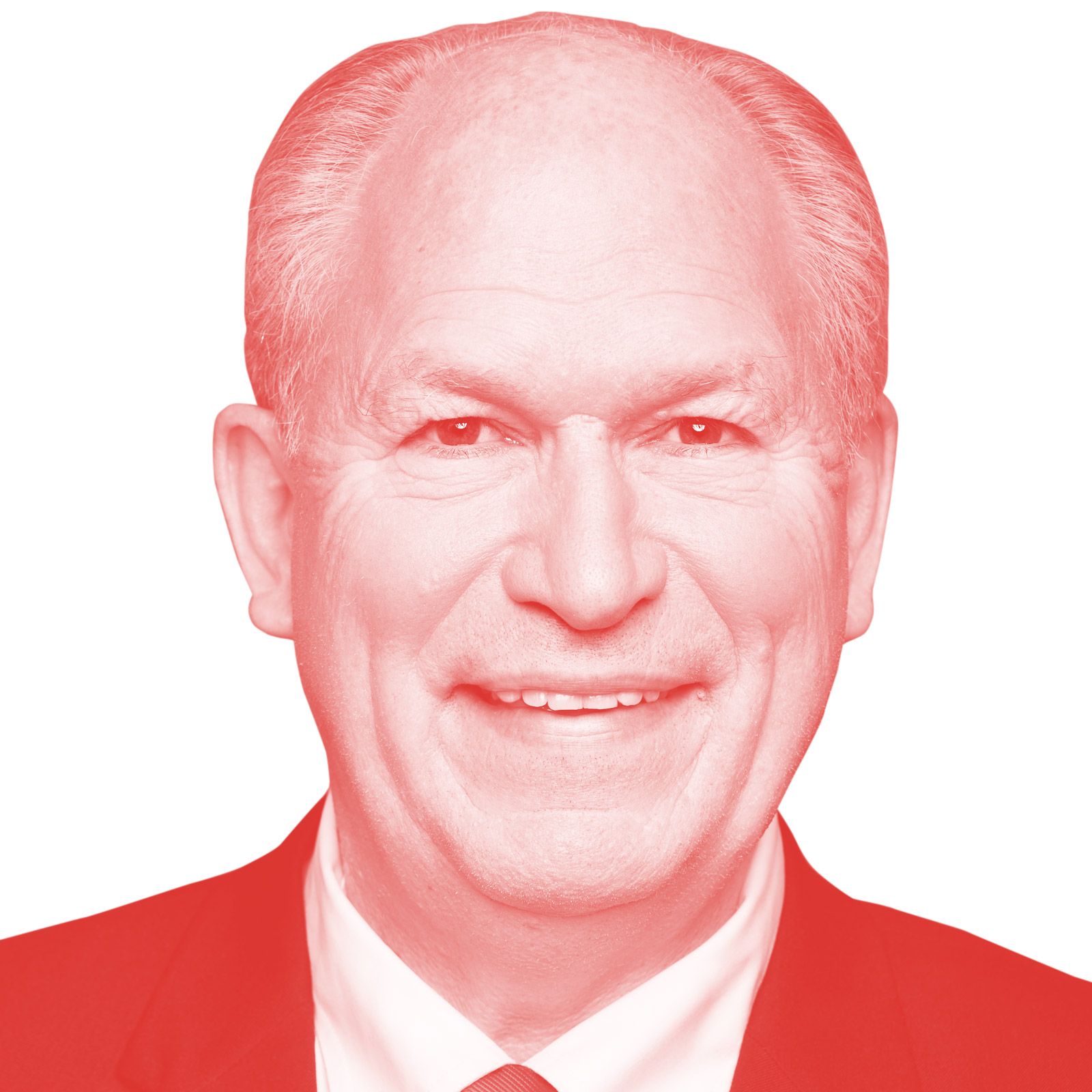
Bill Walker
(independent,
Alaska)
Bill Walker
(independent,
Alaska)
How vulnerable is the seat?
Why is it in play? In 2014, Bill Walker, a Republican oil-and-gas lawyer, beat incumbent GOP governor Sean Parnell by turning independent andpairing with with Democratic nominee Byron Mallott as a running mate. The risky and unprecedented move paid off, and Walker became the first independent to become Alaska’s governor. The first half of Walker’s term was marked by some equally risky moves, as he tried to walk a moderate line and please both the conservatives who defected from Parnell to support him and his running mate’s liberal base. His administration bypassed the objections of the GOP State Legislature to expand Alaska’s Medicaid program and raised taxes to try to solve a budget crisis. At the same time, they continually sparred with the Obama administration over restrictions on oil and gas drilling. During his first two years in office, Walker had some of the highest approval ratings of any governor in America. But, in 2016, in an attempt to plug a multibillion-dollar deficit, he slashed the amount of state oil profit distributed annually to each resident of Alaska by more than half. His approval rating has fallen ever since, to 40 percent as of October 2017. Walker and Mallott will seek reelection on the independent ticket in 2018, facing challengers from both the right and the left. The Alaska GOP has tried to paint him as far left; while the Democrats have said they’re committed to a primary process to find a candidate to run against the incumbents. Who are the challengers? Mark Begich, a former Democratic senator and mayor of Anchorage who lost his Senate seat to a Republican in 2014 has been rumored to be interested in the Democratic nomination. But so far he has said little publicly. On the GOP side, Scott Hawkins, who chairs acontroversial Alaska PAC that funnels money from D.C. to conservative candidates in the state, entered the race in late September. Hawkins has been vocally opposed to the state’s income tax and believes that many of the state’s fiscal problems can be solved by upping the capacity of the trans-Alaska pipeline system. Two state legislators, former State Senator Charlie Huggins and current representative Mike Chenault, have also filed papers to run. |
||||||
| MN | Mark Dayton (Open) | 5.6% | Clinton 46.4% | democrat | ||

Mark Dayton (Open)
(democrat,
Minnesota)
Mark Dayton (Open)
(democrat,
Minnesota)
How vulnerable is the seat?
Why is it in play? Incumbent Mark Dayton of the Democratic–Farmer–Labor Party (Minnesota’s offshoot of the Democratic Party) is well liked throughout the state, but after winning his second term as governor in 2014, he announced that it would be his last. The field to replace him is packed. Minnesota has long been seen as solidly blue; the last time the GOP won a statewide office there was in 2006. But Trump came very close to taking the state in 2016. Clinton wrung out a victory despite winning only nine of the state’s 87 counties, in a stark illustration of the political divide between the liberal Twin Cities and the far more conservative rural areas. Republicans have used their rural advantage to take control of the State Legislature, and now the party hopes that its statewide losing streak may be coming to a close, though it’s still unclear whether it has the demographics to win in solidly liberal urban districts. Who are the challengers? There are six candidates from the DFL and nine from the GOP already, and a handful of others are still reportedly considering a run. Republican Jeff Johnson, a county supervisor who ran for governor in 2014 and was the Minnesota chairman for Marco Rubio’s presidential campaign, won the state’s highly unscientific “corn poll” and received an early endorsement from Rubio, who won the state’s GOP primary. Both bode well for Johnson’s name recognition in a crowded field. On the DFL side, state auditor Rebecca Otto entered the race early and has put forward some of the most comprehensive legislative plans, particularly when it comes to statewide single-payer health care, which she vocally supports. She’s one of the furthest left in the field, and plans to go after Sanders-style progressives. Around the state, she’s known as a politician who sticks to her principles even when they’re unpopular — the flip side being that Republicans in the legislature tend to consider her intractable. Whether a hard-line approach will be the right one in Minnesota is an open question. The retired Minnesota senator and vice-president Walter Mondale threw his support behind Congressman Tim Waltz. Waltz is known for walking a moderate line to turn his normally swing district into a safe bet for the Democrats, even during the 2010 tea party extravaganza. Those skills could be useful in winning over the varied districts in the state, but he’ll take a lot of hits from the left before he can get there, particularly on hot issues like his support for the Second Amendment. |
||||||
| MD | Larry Hogan | 3.8% | Clinton 60.3% | republican | ||

Larry Hogan
(republican,
Maryland)
Larry Hogan
(republican,
Maryland)
How vulnerable is the seat?
Why is it in play? One of three Republican governors in deep-blue states, Hogan snuck into office in 2014 on a low midterm turnout and a high rateof Democratic voters buying into his promise to lower taxes. The usual tie-him-to-Trump tactics might not work in Maryland: Hogan is quite popular, with recent approval ratings as high as 68 percent, he voted for his dad instead of Trump in 2016, and he’s been a frequent critic of the president, on issues ranging from Charlottesville to the withdrawal from the Paris climate agreement. Still, that R next to his name will make him vulnerable in a high-turnout midterm, especially as Maryland will be hit hard by the Republican tax plan. Who are the challengers? Rushern Baker, a county executive representing Maryland’s wealthy D.C. suburbs, leads in the most recent poll, trailing the popular governor by just seven points. He hopes to expand his county’s recent economic gains at the state level to become the state’s first African-American governor. Kevin Kamenetz, a county exec representing Baltimore, is running on a strong record of business development and public school investment. A former NAACP president and ethical investment broker, Ben Jealous represents the left wing of the party, with a key endorsement from Bernie Sanders and a platform including a $15 minimum wage, single-payer health care, and debt-free college programs. Whoever takes the primary nomination in June, it’s sure to be a more expensive race than last round: The 2018 midterm marks the first full cycle since a Supreme Court ruling nixed a $10,000 cap for individual donors, ushering in the late entry of the Citizens United era in Maryland. |
||||||
| NH | Chris Sununu | 1.9% | Clinton 47.6% | republican | ||

Chris Sununu
(republican,
New Hampshire)
Chris Sununu
(republican,
New Hampshire)
How vulnerable is the seat?
Why is it in play? Chris Sununu became the first Republican governor here in 12 years when he narrowly won election to his first term in 2016. (New Hampshire, like Vermont, holds gubernatorial elections every two years.) He won by less than 2 percent, despite the strongest name recognition a candidate could ask for: He’s the son of former governor John H. Sununu and younger brother of former Senator John E. Sununu. His win established a Republican triumvirate, but the state is still sharply divided: Clinton barely won there in 2016, and Democrats won six out of eight elections last year in the state house and senate. And while Sununu’s very popular (he has a 59 percent approval rating), his association with the Republican Party could end up costing him. Who are the challengers? There’s no sign of a Republican primary challenger, and Democrats are having some trouble recruiting a candidate as well. Democrat Steve Marchand didn’t make it out of his party’s primary when he ran for governor in 2016, but he announced his candidacy early and has been touring the state ever since. Other potential challengers include Mark Connolly, the former New Hampshire deputy secretary of State and 2016 gubernatorial candidate, and former attorney general Joseph Foster. |
||||||
| WI | Scott Walker | 5.67% | Trump 47.2% | republican | ||
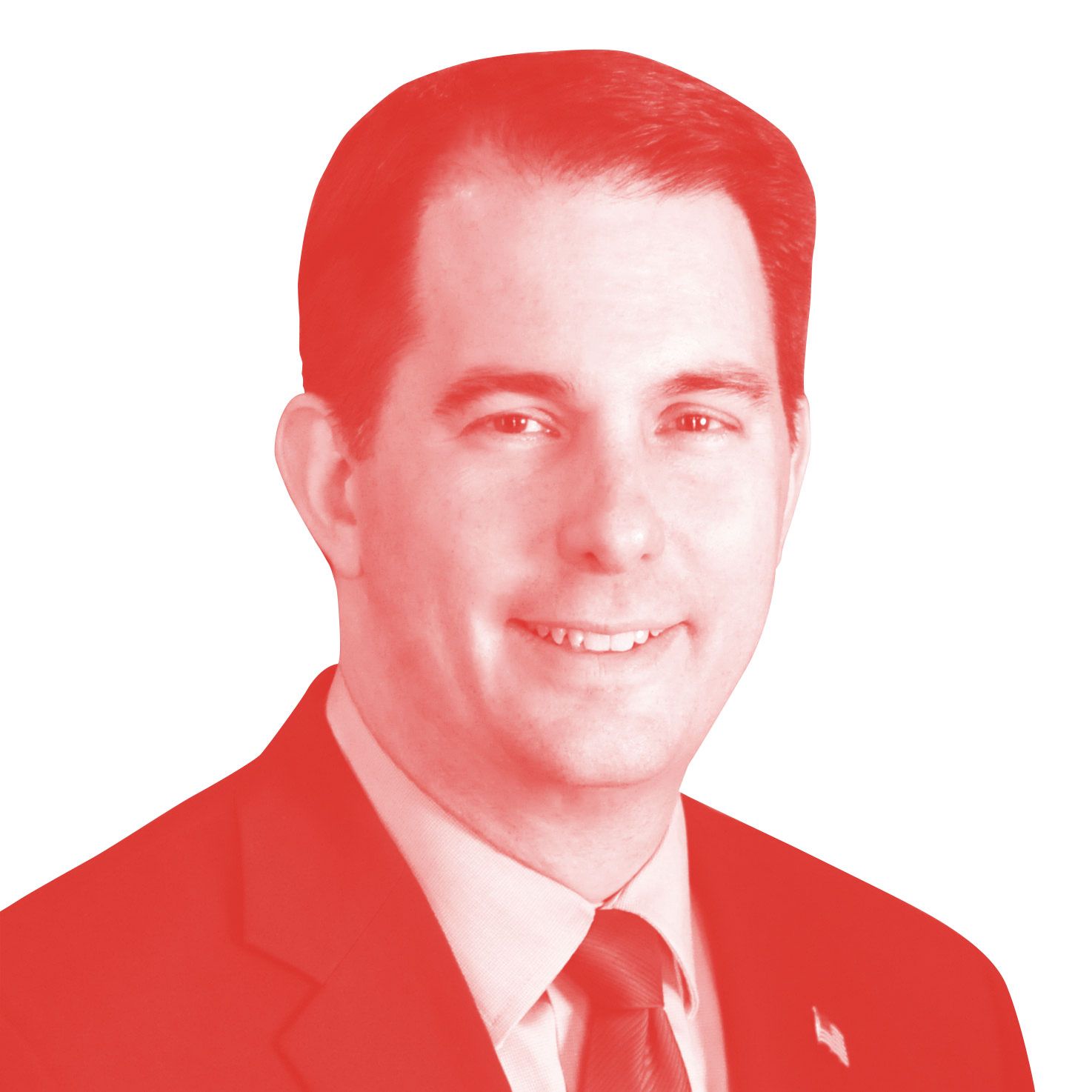
Scott Walker
(republican,
Wisconsin)
Scott Walker
(republican,
Wisconsin)
How vulnerable is the seat?
Why is it in play? An early casualty in the 2016 Republican primary, Scott Walker has remained a close Trump ally, from health care to the NFL protests — inevitably, the Democratic nominee will stress this link in a state where Trump’s approval rating is at 41 percent. In eight years, Walker has boosted the state’s economy, slashed its property taxes, and won three elections (including the 2012 recall), yet he’s never earned more than 53 percent of the vote, and his approval rating has been below 50 percent since 2015. An early campaign promise could make for an easy target as well — he’s nowhere near the 250,000 jobs he promised to bring to the state in his first campaign.National interests are weighing in against Walker, hoping to bridge the gap in another potentially close race. After a banner year in fundraising, the ACLU is targeting Walker in its unprecedented 2018 push. And the national union that represents public workers has bought in, after Walker notoriously slashed Wisconsin’s public-sector unions. Who are the challengers? The field for the Democratic primary has been called “the most crowded in a generation,” with 16 registered candidates. The usual dynamics of a statewide election may not apply; a Democrat must normally perform in Milwaukee and Madison to win the primary, but this year, someone could marshal a smaller, unconventional set of voters and win. Tony Evers, the state’s schools superintendent, is by default the front-runner, if only because he’s the only candidate to have ever won a competitive general election. Last year, in the race for his current position, he carried over 255,000 votes, which is expected to surpass the number the winner will grab in the August primary. Former party chairman Matt Flynn enjoys strong name recognition and is in sync with the concerns of the state’s Democratic voters, including a strong stance against the controversial Foxconn deal last year. No candidate has emerged as a true favorite, but that might not be a killer in the general election — in 2014, candidate Mary Burke was largely unknown and outspent and came within six points of the well-funded incumbent. Democrats hope that the midterm bump could put them over the edge, though getting enough money to play in a short, three-month general election could be a problem. As of his last filing, Walker had $2.4 million on hand, compared to the five-figure sums of most Democratic candidates. |
||||||

